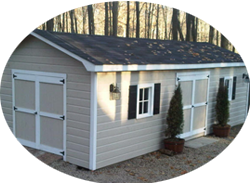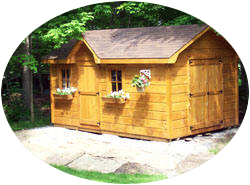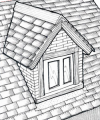 |
 |











Heritage
Creations
Glossary of Terms
Bunkie
 The
basic features of bunkies are windows, flooring, sometimes
heating and enough space for a bed and side-table. A Bunkie as
small as 12 X 8 feet will fit a queen size bed.
The
basic features of bunkies are windows, flooring, sometimes
heating and enough space for a bed and side-table. A Bunkie as
small as 12 X 8 feet will fit a queen size bed.
Dormer
 A
dormer is a structural element of a building that protrudes from
the plane of a sloping roof surface. Dormers are used, either in
original construction or as later additions, to create usable
space in the roof of a building by adding headroom and usually
also by enabling addition of windows.
A
dormer is a structural element of a building that protrudes from
the plane of a sloping roof surface. Dormers are used, either in
original construction or as later additions, to create usable
space in the roof of a building by adding headroom and usually
also by enabling addition of windows.
Gable
 A
gable is the generally triangular portion of a wall between the
edges of a sloping roof. The shape of the gable and how it is
detailed depends on the structural system being used (which is
often related to climate and availability of materials) and
aesthetic concerns. Thus the type of roof enclosing the volume
dictates the shape of the gable.
A
gable is the generally triangular portion of a wall between the
edges of a sloping roof. The shape of the gable and how it is
detailed depends on the structural system being used (which is
often related to climate and availability of materials) and
aesthetic concerns. Thus the type of roof enclosing the volume
dictates the shape of the gable.
Kiln Drying
 The
process of kiln drying consists basically of introducing heat.
In the process, deliberate control of temperature, relative
humidity and air circulation is provided to give conditions at
various stages (moisture contents or times) of drying the timber
to achieve effective drying. For this purpose, the timber is
stacked in chambers, called wood drying kilns, which are fitted
with equipment for manipulation and control of the temperature
and the relative humidity of the drying air and its circulation
rate through the timber stack. Kiln drying provides a means of
overcoming the limitations imposed by erratic weather
conditions.
The
process of kiln drying consists basically of introducing heat.
In the process, deliberate control of temperature, relative
humidity and air circulation is provided to give conditions at
various stages (moisture contents or times) of drying the timber
to achieve effective drying. For this purpose, the timber is
stacked in chambers, called wood drying kilns, which are fitted
with equipment for manipulation and control of the temperature
and the relative humidity of the drying air and its circulation
rate through the timber stack. Kiln drying provides a means of
overcoming the limitations imposed by erratic weather
conditions.
Oriented Strand Board
 Oriented strand board, also known as OSB, waferboard,
Sterling board or Exterior board (UK) and SmartPly (UK &
Oriented strand board, also known as OSB, waferboard,
Sterling board or Exterior board (UK) and SmartPly (UK &
 Ireland), is an engineered wood product formed by layering
strands (flakes) of wood in specific orientations. In
appearance, it may have a rough and variegated surface with the
individual strips (around 2.5 by 15 cm (approx. 1 in by 6 in)
each) lying unevenly across each other.
Ireland), is an engineered wood product formed by layering
strands (flakes) of wood in specific orientations. In
appearance, it may have a rough and variegated surface with the
individual strips (around 2.5 by 15 cm (approx. 1 in by 6 in)
each) lying unevenly across each other.
Tounge and Groove Joint

Tongue and groove or T&G is a method of fitting similar objects together, edge to edge, used mainly with wood: flooring, parquetry, panelling, and similar constructions. Tongue and groove joints allow two flat pieces to be joined strongly together to make a single flat surface. Each piece has a slot (the groove) cut all along one edge, and a thin, deep ridge (the tongue) on the opposite edge. The tongue projects a little less than the groove is deep. Two or more pieces thus fit together closely. The joint is not normally glued, as shrinkage would then pull the tongue off.
Truss
 A truss is composed of triangles because of the structural
stability of that shape and design. A triangle is the simplest
geometric figure that will not change shape when the lengths of
the sides are fixed. In comparison, both the angles and the
lengths of a four-sided figure must be fixed for it to retain
its shape.
A truss is composed of triangles because of the structural
stability of that shape and design. A triangle is the simplest
geometric figure that will not change shape when the lengths of
the sides are fixed. In comparison, both the angles and the
lengths of a four-sided figure must be fixed for it to retain
its shape.
